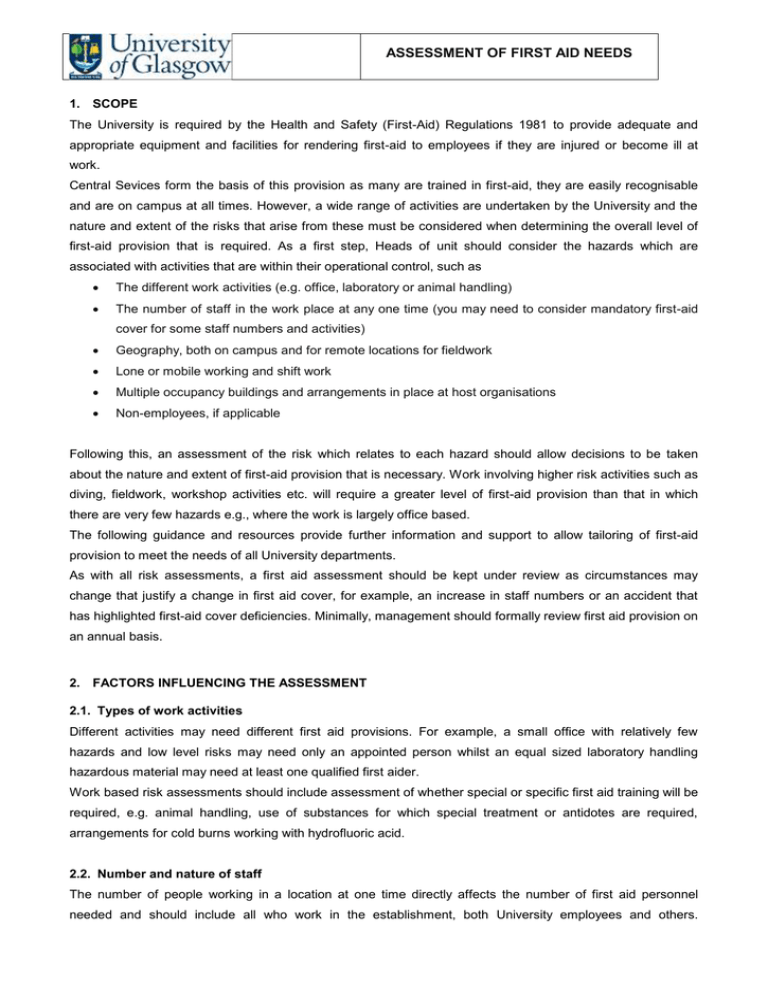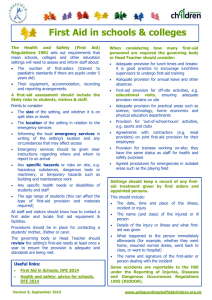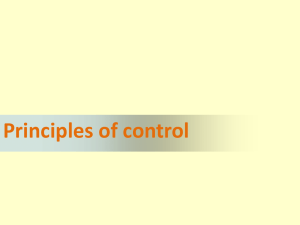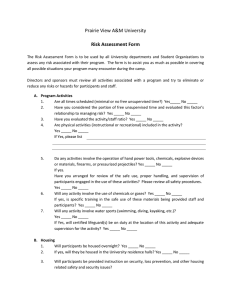ASSESSMENT OF FIRST AID NEEDS
advertisement

ASSESSMENT OF FIRST AID NEEDS 1. SCOPE The University is required by the Health and Safety (First-Aid) Regulations 1981 to provide adequate and appropriate equipment and facilities for rendering first-aid to employees if they are injured or become ill at work. Central Sevices form the basis of this provision as many are trained in first-aid, they are easily recognisable and are on campus at all times. However, a wide range of activities are undertaken by the University and the nature and extent of the risks that arise from these must be considered when determining the overall level of first-aid provision that is required. As a first step, Heads of unit should consider the hazards which are associated with activities that are within their operational control, such as The different work activities (e.g. office, laboratory or animal handling) The number of staff in the work place at any one time (you may need to consider mandatory first-aid cover for some staff numbers and activities) Geography, both on campus and for remote locations for fieldwork Lone or mobile working and shift work Multiple occupancy buildings and arrangements in place at host organisations Non-employees, if applicable Following this, an assessment of the risk which relates to each hazard should allow decisions to be taken about the nature and extent of first-aid provision that is necessary. Work involving higher risk activities such as diving, fieldwork, workshop activities etc. will require a greater level of first-aid provision than that in which there are very few hazards e.g., where the work is largely office based. The following guidance and resources provide further information and support to allow tailoring of first-aid provision to meet the needs of all University departments. As with all risk assessments, a first aid assessment should be kept under review as circumstances may change that justify a change in first aid cover, for example, an increase in staff numbers or an accident that has highlighted first-aid cover deficiencies. Minimally, management should formally review first aid provision on an annual basis. 2. FACTORS INFLUENCING THE ASSESSMENT 2.1. Types of work activities Different activities may need different first aid provisions. For example, a small office with relatively few hazards and low level risks may need only an appointed person whilst an equal sized laboratory handling hazardous material may need at least one qualified first aider. Work based risk assessments should include assessment of whether special or specific first aid training will be required, e.g. animal handling, use of substances for which special treatment or antidotes are required, arrangements for cold burns working with hydrofluoric acid. 2.2. Number and nature of staff The number of people working in a location at one time directly affects the number of first aid personnel needed and should include all who work in the establishment, both University employees and others. Assessing the number of first aiders required based upon staff numbers is only the start, other factors could well demand a higher first aider/staff ratio (see sections below). If there are new or expectant mothers, or young persons amongst the staff, their needs should also be accounted for as part of the assessment. What level of risk First aid personnel do you needed Where there are small numbers of employees or the work is low hazard, the minimum provision is: Where there are large numbers of employees even in a low hazard environment, the minimum provision is: Fewer than 25 Appointed person 25 – 50 At least 1 first aider More than 50 At least one first aider for every 100 employee Higher Hazard – light engineering and assembly work, food processing, warehousing, dangerous equipment, sharp instruments, construction and chemical processing Fewer than 5 Appointed person 5 – 50 At least 1 trained first aider More than 50 At least one first aider for every 50 employee 2.3. History of accidents Information collected when investigating previous accidents/incidents should be used when assessing the adequacy of future first-aid provision. For large and/or multi-site organisations, this information could be helpful in determining where first-aiders should be located, what geographical area they should be required to cover and what first-aid equipment is necessary. 2.4. Location If there is difficult or slow access to emergency medical assistance, for example, at a remote location, on site facilities may need to be increased, e.g. having a first aid room. If there are isolated buildings or areas (e.g. a quarantine animal facility) the assessment should recognise these factors and make increased provision, for example, having a designated first aider in each isolated area. 2.5. Lone, mobile and remote working Working alone, travelling or working remotely brings attendant risks exacerbated by isolation, whether within the unit (e.g. out of hours) or in the community. What is a minor situation when others are nearby can be life threatening when unable to obtain immediate assistance. Each lone, mobile and remote working task should be assessed individually. 3. FIRST AID PERSONNEL An employer is required by the Regulations to appoint one or more of two groups of trained personnel, qualified first-aiders and appointed persons. Foreseeable absence such as annual leave, sick leave and special leave (such as bereavements) must be accounted for, to ensure there is adequate first aid provision at all times. A list of all current first aiders and appointed persons together with their location should be made available to all staff, posted near or on all first aid boxes and included in the local health and safety policy/management document. 2 Staff who work remotely or travel frequently on University business should have a basic knowledge, but not necessarily at qualified first aider level. 3.1. Designated first aiders First aid treatment may only be administered by people who have completed an approved training course and, where necessary, attended a refresher training course. All those given the title “first aider” must have a current first aid certificate. The following criteria should be applied when selecting staff for first aid training: Able to leave their work place immediately when required Calm, especially in pressured situations Reliable and able to communicate Able to cope with any injuries or ill-health likely to occur in their work place (able to stand the sight of blood) 3.2. Appointed persons Where your assessment of first-aid needs identifies that a trained first-aider is not required in your workplace, you should appoint someone to take charge of first-aid arrangements. This is the minimum requirement. Even in a small, low-hazard workplace where first-aiders are not considered necessary, there is always the possibility that an accident or sudden illness may occur. It is therefore important that there is always someone available to take charge of these arrangements. The role of this appointed person includes looking after first-aid equipment and facilities and calling the emergency services when required. They can also provide emergency cover where a first-aider is absent due to unforeseen circumstances (does not include annual leave). An appointed person does not need first-aid training 4. FIRST-AID BOXES/CONTAINERS First aid kits are a legal requirement for every workplace. It must also be clearly marked in a green box with a white cross on it. The staff should all be made aware of where their nearest first aid box is located; it should be easily accessible for people and the contents should be checked regularly to make sure all items are in stock and in date. The number and contents of first aid boxes depends upon several factors, e.g. number and distribution of staff, remoteness and the type of work undertaken. First aid boxes must not contain tablets, medication or pharmaceutical preparations. First aid boxes, containers or kits, should be in easily accessible places, preferably in a clean area or room, and should be protected from dust and damp. First aid boxes will need to be replenished periodically. A member of staff should be given responsibility for ensuring that the contents are complete at all times. Staff should be asked to inform the responsible person whenever an item is removed. It is best practise to conduct a recorded monthly inspection of your first aid box. Contents of a first aid kit should be relevant to the risks and needs of the area where the kit is likely to be used. For example, if burns are a possibility, then burn relief products should be part of your first aid measures. 3 4.1. Contents of First Aid Box The HSE does not specify what should be in the first aid box and the list below is only a suggested contents list. Departments may wish to refer to British Standard BS 8599 which provides further information on the contents of workplace first-aid kits. The contents should reflect the outcome of the first-aid needs assessment. In most cases first-aid boxes should contain the following items: Qty Guidance card or leaflet; 1 Individually wrapped sterile adhesive dressings (assorted sizes) 20 Sterile eye pads, with attachment 2 Individually wrapped triangular bandages 6 Safety pins 6 Medium sized individually wrapped sterile wound dressings (approx 10cm x 8 cm) 6 Large sterile individually wrapped wound dressings (approx 13cm x 9cm) 2 Extra-large sterile individually wrapped wound dressings (approx 28cm x 17.5cm) 3 Recommended: Disposable gloves and disposable mouth-to-mouth resuscitation masks Travelling first aid kits Where staff work away from the normal workplace, travelling kit may need to be provided. In some instances this may also apply to those who routinely use their own or hired transport for work activities. Eye wash facilities All areas where there is a risk of eye injury (i.e. all laboratories, workshops and animal houses) must have suitable eye wash facilities. These take a number of forms, from fixed eye showers to eye wash stations with single use sterile bottles. Staff in these areas should be trained in the use of the local provision. It is vital that any eye wash provision is correctly maintained. A written procedure should be developed to ensure that single use eye wash bottles are in date and seals are not broken. It should also make provisions to inspect eye wash showers to ensure that they are functional and are not blocked or filled with contaminated water (rust can form in unused units and conditions could enable growth of Legionella when the eye-wash station has not been used for some time). 4.2. HOW OFTEN SHOULD THE CONTENTS OF FIRST-AID BOXES BE REPLACED? Although there is no specified review timetable, many items, particularly sterile ones, are marked with expiry dates. Expired items should be disposed of safely and stocks replenished with new items. In cases where sterile items have no dates, it would be advisable to check with the manufacturers to find out how long they can be kept. For non-sterile items without dates, it is a matter of judgement based on their general condition. 5. TRAINING Local first aiders should be granted suitable time off for training.Trained first aiders are those who have successfully completed a recognised course from a certified provider. Initial training is usually three days and 4 refresher training is two days. All qualified first aiders will require requalification within three years to retain their first-aider status. An annually half-day refresher for first aiders is recommended. Appointed persons should have been on a suitable training course. Courses normally last half a day and cover the following topics: What to do in an emergency Cardio-pulmonary resuscitation First-aid for the unconscious casualty First-aid for the wounded or bleeding Information on how to book first aid courses is available on the SEPS website. Staff that are embedded within NHS premises or other partner institutions may find their host already has suitable training arrangements that can be tapped into. Ensure that the offered course meets your needs, extending the curriculum if necessary beyond the general provision to encompass any special needs the work of the unit may require. 6. SHARED FACILITIES First aid facilities (e.g. boxes or first aid rooms) There is no point in unnecessary repetition of first aid facilities. If staff are based in a shared building then agreement should be sought with the host or other occupants for collective first aid provision with one party providing a service that the others subscribe to. Managers should ensure that the offered first-aid provisions have been adequately assessed and are suitable and sufficient for the work and staff numbers of their establishment. Personnel Similarly, arrangements for first aid personnel cover may also be shared, providing the correct number of suitably trained personnel are available. Non-employees The Regulations do not require an employer to make first aid provisions for any person other than his employees. However, when calculating first-aid needs, an allowance for “permanent” visitors should be made and others who are on the premises on a regular basis, e.g. volunteers or students. 5


